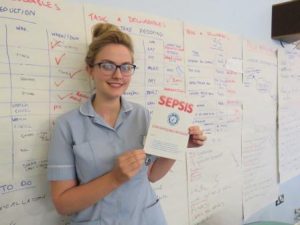Patients being treated for Sepsis have seen huge improvements in their care at Shropshire’s two acute hospitals – thanks to the introduction of techniques used by ‘the USA’s Hospital of the Decade’.

Staff Nurse Viola Jones
The Shrewsbury and Telford Hospital NHS Trust (SaTH) has been working to improve care for patients who suffer Sepsis and has been using techniques learnt from the Virginia Mason Institute (VMI) in Seattle, as part of a five-year partnership.
The latest target progress report on Sepsis, which comes 60-days after SaTH held a Rapid Process Improvement Week (RPIW) about improving the way patients presenting with Sepsis are screened, shows a significant reduction in lead times, waste and quality defects.
Sepsis arises when the body’s response to an infection injures its own tissues and organs. It leads to shock, multiple organ failure and death, especially if not recognised early and treated promptly. There are around 150,000 cases of Sepsis in the UK every year and approximately 44,000 deaths. It is hoped that the improvements, another milestone in the exciting five-year partnership VMI will significantly reduce the number of people who die from Sepsis at SaTH.
Staff Nurse Viola Jones, who is the Process Owner of the Sepsis Value Steam, said: “When challenged to improve screening and recognition of Sepsis we found some people didn’t have a clear understanding of what Sepsis is. To combat this we produced a simple leaflet that explains what Sepsis is that comes with an informative quiz to ensure the information learnt in the leaflet is retained. Staff are encouraged to submit their answers and are then presented with a certificate of achievement.
“The information leaflet has proved a huge success and we have been asked to share it with The UK Sepsis Trust and a number of other hospital Trusts. Every member of staff on the Acute Medical Unit (AMU) has completed the quiz and we hope to roll it out to every employee in the near future.
“The leaflet has helped empower staff and make them more aware of Sepsis, which as a result improves screening and recognition of Sepsis for our patients.”
The leaflet, along with other initiatives such as introducing a user-friendly sepsis tool in the nursing documentation, means we have managed to reduce the cycle time for the completing of nursing documentation from 45 minutes to just 10 minutes (78 per cent). The cycle time for this is from the moment the patient has observations recorded to when the Sepsis screening tool is used.”
Huge improvements to patients’ privacy and dignity have also been achieved over the past 60 days.
Viola said: “By stepping away from my clinical role on AMU at The Princess Royal Hospital (PRH) in Telford, to focus on screening and recognition of sepsis with the RPIW ‘Away Team’, initial observations showed that 80 per cent of patients were having their observations and swab tests taken in a public area.
“By using 5S methodology we reorganised the doctor’s consultation room to make the workspace more efficient and effective. Nurses are now also able to use the room to conduct observations and tests in a private setting. Patient privacy and dignity is of huge importance to everyone at the Trust so we are delighted to report not a single breach since the implementation of this room 60 days-ago.”
Other significant reductions in waste include the number of steps staff must walk to get a wheelchair (was 409, now 29) and the observation machine (was 62, now two). The number of steps patients walk before they are reviewed for signs and/or symptoms of Sepsis has been reduced by 74 per cent, from 84 to just 22.
At least four patients at SaTH die each month from Sepsis. Early recognition and screening for Sepsis is vital to ensure timely and effective treatment.
Dr Edwin Borman, Medical Director at SATH, said: “Sepsis can prove fatal and patients who develop the condition can deteriorate very, very quickly.
“Sadly, in our hospitals, around four patients a month die from Sepsis, along with other cases where the patient does not reach us in time. We want to reduce that number by at least half and believe that we can do so by increasing awareness of the condition and improving treatment.
“I have been extremely impressed by the work done over the past 60-days and look forward to hearing what further improvement have been made at the 90-day target progress report out.”
